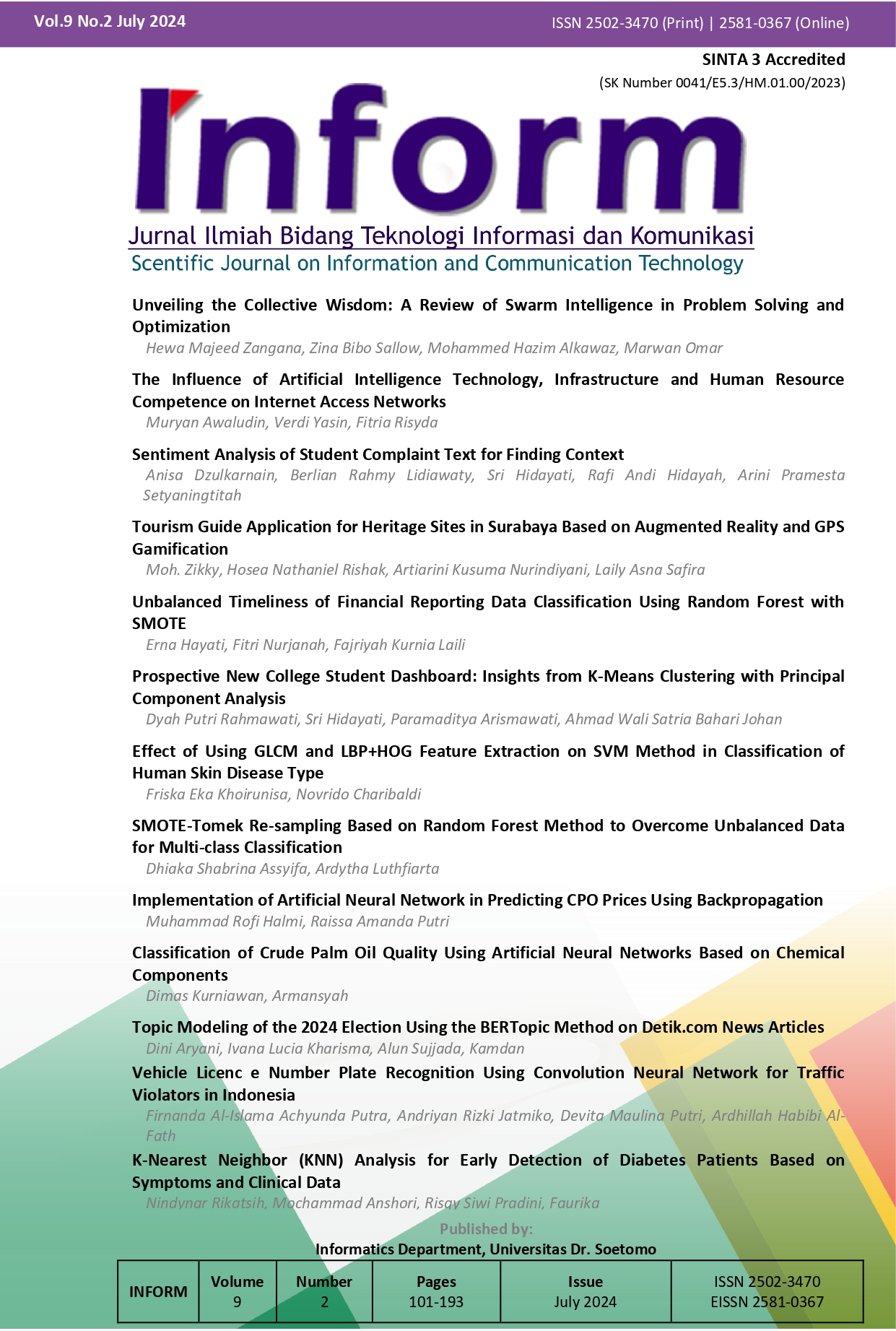Classification of Crude Palm Oil Quality Using Artificial Neural Networks Based on Chemical Components
 Abstract views: 167
,
Abstract views: 167
,
 PDF downloads: 100
PDF downloads: 100
Abstract
Palm oil, known as Crude Palm Oil (CPO), is a flagship product in the palm oil industry, playing a crucial role in the economies of various tropical countries such as Indonesia. This study aims to classify the quality of CPO based on chemical components using the Artificial Neural Networks (ANN) method with a backpropagation algorithm. The research data was obtained from PT. Perkebunan Lembah Bhakti (PLB) 2 from January to October 2023, consisting of 225 entries with five main chemical variables: impurity level, moisture content, free fatty acid (FFA) level, Deterioration of Bleachability Index (DOBI), and carotenoids. The data preprocessing stage involved transforming and normalizing the data using the Z-score method. The ANN model used has a 5-5-2 architecture with ReLU activation functions for the input and hidden layers and a Softmax function for the output layer. Model evaluation was conducted using accuracy metrics, which showed that the ANN model could classify CPO quality with an accuracy of 97.78% on the test data. The research results show that ANN can classify CPO quality with a high level of accuracy. This indicates that this method has great potential for use in the industry to improve CPO quality assessment. The improvement in accuracy and validity of the ANN classification results has significant implications for the industry. With high accuracy, ANN can reduce human errors in quality assessment, speed up the process, and increase the consistency of assessment results. This is crucial because consistent quality assessment can enhance operational efficiency and reduce production costs.
References
L. Murjana, “Analisa Pengendalian Kualitas Crude Palm Oil (CPO) dengan menggunakan Metode Statistical Quality Control (SQC) pada PT. Sapta Karya Damai Kalimantan Tengah,” UPN Veteran Jawa Timur, 2022.
D. Nurhasanah, D. A. Lestari, and S. Simatupang, “Pemilihan Kualitas Produk Kelapa Sawit Menggunakan Metode Naive Bayes di Labuhanbatu Selatan,” J. Tek., vol. 3, no. 1, pp. 24–31, 2023.
H. Aini, H. Haviluddin, E. Budiman, M. Wati, and N. Puspitasari, “Prediksi Produksi Minyak Kelapa Sawit Menggunakan Metode Backpropagation Neural Network,” Sains, Apl. Komputasi dan Teknol. Inf., vol. 1, no. 1, pp. 24–33, 2019.
D. A. Raihan, D. Syauqy, and B. H. Prasetio, “Klasifikasi Kualitas Beras berdasarkan Nilai Data Larik Sensor Gas MQ menggunakan Metode Jaringan Syaraf Tiruan berbasis Arduino,” … Inf. dan Ilmu Komput. e-ISSN, vol. 6, no. 6, pp. 2974–2981, 2022.
Jusrawati, A. Futri, and A. B. Kaswar, “Klasifikasi Tingkat Kematangan Buah Pisang Dalam Ruang Warna RGB Menggunakan Jaringan Syaraf Tiruan ( JST ),” vol. 02, no. May, pp. 49–54, 2021.
M. Ikhsan, A. Armansyah, and A. A. Tamba, “Implementasi Jaringan Syaraf Tiruan Backpropagation Pada Klasifikasi Grade Teh Hitam,” J. Sist. Komput. dan Inform., vol. 4, no. 2, pp. 387–395, 2022.
F. Erlangga, D. R. Wijaya, and W. Wikusna, "Electronic Nose Dataset for Classifying Rice Quality using Neural Network," in 2021 9th International Conference on Information and Communication Technology (ICoICT), 2021, pp. 462–466. doi: 10.1109/ICoICT52021.2021.9527423.
M. Z. Sarwani and D. A. Sani, "Social Media Analysis Using Probabilistic Neural Network Algorithm to Know Personality Traits," Editor. BOARD, vol. 6, no. 1, 2020.
S. Jesika, S. Ramadhani, and Y. P. Putri, “Implementasi Model Machine Learning dalam Mengklasifikasi Kualitas Air,” J. Ilm. Dan Karya Mhs., vol. 1, no. 6, pp. 382–396, 2023.
D. Monika, A. Ahmad, S. Wardani, and Solikhun, “Model Jaringan Syaraf Tiruan Dalam Memprediksi Ketersediaan Cabai Berdasarkan Provinsi,” Teknika, vol. 8, no. 1 SE-Articles, Jun. 2019, doi: 10.34148/teknika.v8i1.140.
R. Rahmiyanti, S. Defit, and Y. Yunus, “Prediksi dan Klasifikasi Buku Menggunakan Metode Backpropagation,” J. Inf. dan Teknol., pp. 109–114, 2021.
I. Firmansyah and B. H. Hayadi, “Komparasi Fungsi Aktivasi Relu Dan Tanh Pada Multilayer Perceptron,” JIKO (Jurnal Inform. dan Komputer), vol. 6, no. 2, pp. 200–206, 2022.
R. Radikto, D. I. Mulyana, M. A. Rofik, and M. O. Z. Zakaria, “Klasifikasi Kendaraan pada Jalan Raya menggunakan Algoritma Convolutional Neural Network (CNN),” J. Pendidik. Tambusai, vol. 6, no. 1, pp. 1668–1679, 2022.
D. Pardede and B. H. Hayadi, "MotoGP Mandalika 2022 Sentiment Classification Using Machine Learning," J. Transform., vol. 20, no. 2, pp. 42–50, 2023.
J. T. Samudra, B. H. Hayadi, and P. S. Ramadhan, “Komparasi 3 Metode Algoritma Klasifikasi Data Mining Pada Prediksi Kenaikan Jabatan,” J. Teknol. Sist. Inf. dan Sist. Komput. TGD, vol. 5, no. 2, pp. 127–133, 2022.
C. D. Suhendra and A. C. Saputra, “Penentuan parameter learning rate selama pembelajaran jaringan syaraf tiruan backpropagation menggunakan algoritma genetika,” J. Teknol. Inf. J. Keilmuan Dan Apl. Bid. Tek. Inform., vol. 14, no. 2, 2020.
M. A. Ridho and M. Arman, “Analisis Serangan DDoS Menggunakan Metode Jaringan Saraf Tiruan,” J. Sisfokom (Sistem Inf. Dan Komputer), vol. 9, no. 3, pp. 373–379, 2020.
Copyright (c) 2024 Dimas Kurniawan, Armansyah Armansyah

This work is licensed under a Creative Commons Attribution-ShareAlike 4.0 International License.
Authors who publish with Inform: Jurnal Ilmiah Bidang Teknologi Informasi dan Komunikasi agree to the following terms:
-
Authors retain copyright and grant the journal right of first publication with the work simultaneously licensed under a Creative Commons Attribution License (CC BY-SA 4.0) that allows others to share the work with an acknowledgment of the work's authorship and initial publication in this journal.
-
Authors are able to enter into separate, additional contractual arrangements for the non-exclusive distribution of the journal's published version of the work (e.g., post it to an institutional repository or publish it in a book), with an acknowledgment of its initial publication in this journal.
-
Authors are permitted and encouraged to post their work online (e.g., in institutional repositories or on their website) prior to and during the submission process, as it can lead to productive exchanges, as well as earlier and greater citation of published work.











